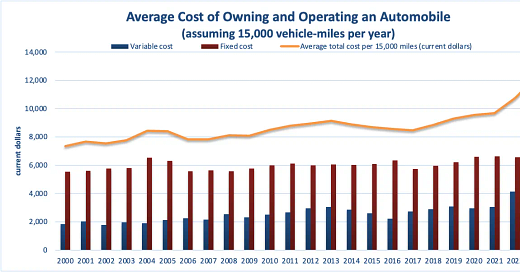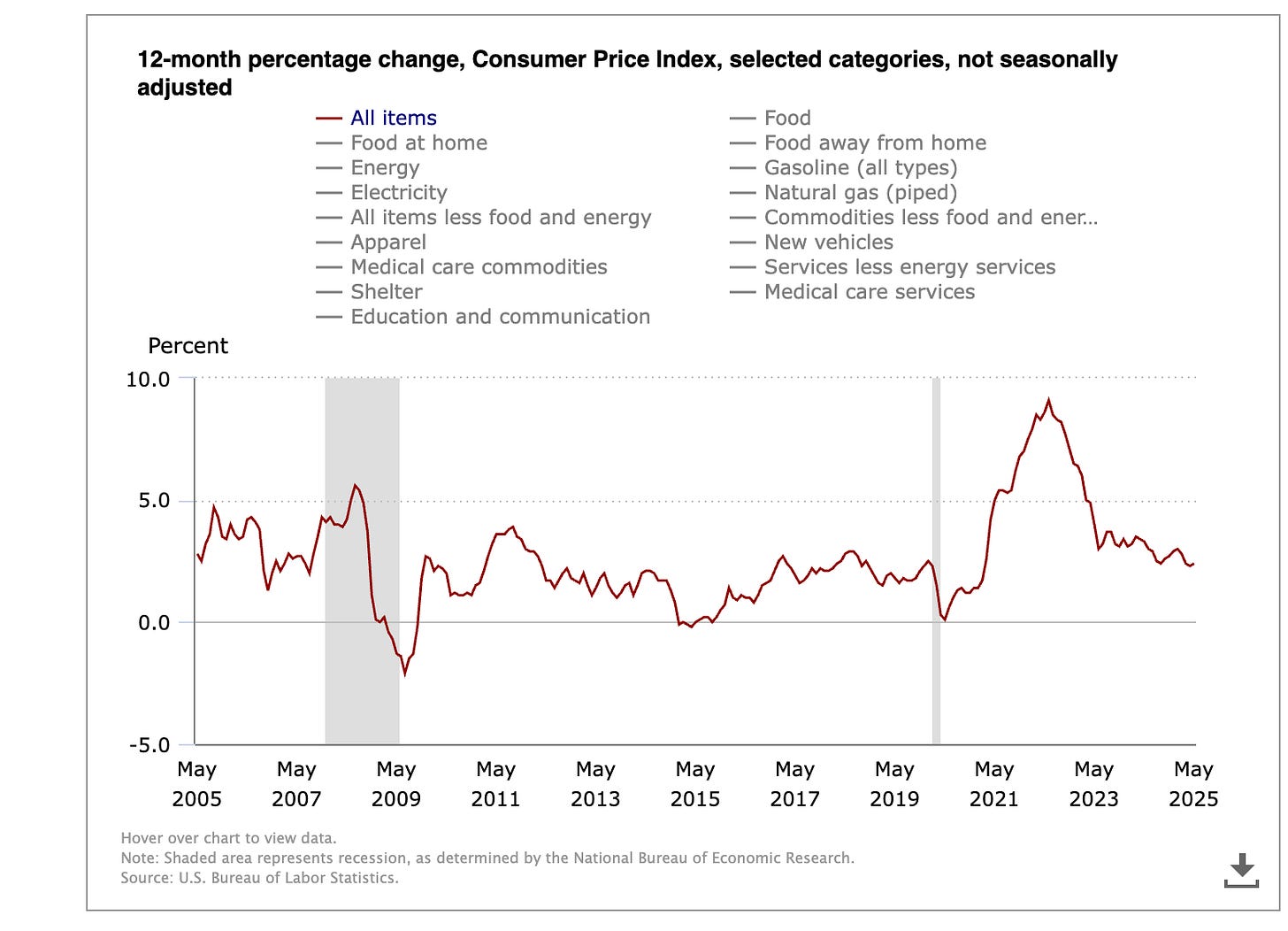Car ownership costs soar up, up and away!
Plus, Tesla's squishy soft robotaxi launch, China's export surge
Greetings from Motown!
First, I had a great time earlier this week talking about Tesla and robotaxis with
of to launch our new channel, At the Wheel. We’re just getting started with livestreams and podcasts. Please sign up and Stay tuned!Let’s look today at the surging costs of owning and driving a car or truck in the United States.
Affordability was a challenge the U.S. industry before Donald Trump began ramping up import taxes earlier this year. Thank the pandemic for that.
But Trump’s tariffs now promise to make matters worse, with potentially serious consequences for consumers and automakers.
Cox Automotive estimated this week that tariffs could boost vehicle prices by 8%, and jack up the price of vehicle repair parts. July 9 is the next big deadline when Trump tariffs could kick in. Or not. Maybe it will be a TACO Wednesday, if automakers are lucky.
With average new car prices rising back toward $49,000, car insurance premiums headed to Uranus and repair bills that zoom to four figures faster than the new Corvette ZR1X can get to 60 MPH, small wonder the U.S. auto market is stuck at annual sales levels 1 million-plus vehicles below pre-pandemic rates.
The view that buying and owning a car is budget-busting folly is breaking again into the mainstream media Zeitgeist, which is not good if you’re trying to sell vehicles.
“High costs have ended America’s love affair cars,” the Wall Street Journal’s Dan Neil declared last week.
“The household auto fleet is a money pit,” Substack writer Andy Boenau (@Urbanism Speakeasy) wrote in Fast Company earlier this month. Boenau wrote:
“Replacing a car with an e-bike can save a household $120,000 over a decade—enough to wipe out debt, fund a college account, or boost retirement savings. And as infrastructure improves with more protected lanes, slower streets, and secure parking, the e-bike can graduate from practical to preferable.”
(Sure, that’s a utopian view if you live in a place like Detroit where the weather is cold and wet six + months of the year and the infrastructure amenities cited are absent in much of the Metro. But Boenau’s headline point is backed up with data, as we’ll see.)
CNBC, no bastion of anti-consumerism, hit the theme with a piece on “Why American Cars Are So Expensive.”
What’s behind all this angst about auto ownership costs?
Consider:
Since 2020, the average cost of owning and operating a vehicle in the United States has risen 29% to $12,296 a year, according to U.S. government data. If you go back 12 years - roughly the average age of vehicles on the road - the annual cost of ownership has risen by 37%, or $3,350.
Maintenance costs per mile have more more than doubled since 2012. Maintenance costs per mile began surging in 2017 from roughly 5 cents per mile to 10.1 cents per mile by 2024. “Fixed costs,” including insurance, taxes, registration fees and depreciation, have risen by 29% since 2020.
Insurance is a significant driver of vehicle ownership costs. The cost of covering a vehicle surged by 84% between May 2020 and May 2025, according to government data, which you can find here.
Granted, the overall inflation picture over the past five years was ugly. But the pace of price increases in the broader economy has slowed down from the pandemic years. Auto ownership costs, not so much.
Auto loan interest rates near 25 year highs inflame the pain, as does college loan debt that forces many consumers into sub-prime loans, Cox Automotive Chief Economist Jonathan Smoke says.
One culprit driving repair cost inflation is the advanced technology that automakers push to bulk up profit margins: Quasi-automated driving systems, automated lane-keeping, radar and camera sensors watching every corner of the vehicle, automated parking systems and of course all the electronics required to comply with pollution rules …. all of it has made vehicles more expensive to repair and insure.
So far, investments in sophisticated on-board safety tech and automated driving systems have not correlated with a significant drop in highway fatalities.
Compared to 20 years ago, highway fatalities per 100 million vehicle miles traveled are down about 15%, according to the latest government data (here.) That’s a positive trend.
But the absolute number of highway deaths still sits on a plateau of between 35,000 and 40,000 tragedies a year. In fact, fewer people died in highway accidents in 1994 than in 2003, although the rate per miles travelled was higher three decades ago at 1.73 deaths per 100 million miles compared to 1.26 in 2023.
Detroit automakers also have made strategic decisions that are now driving the unaffordability trend.
As friend of the High Speed Rodeo Warren Browne writes here in Industry Week, General Motors, Ford and the Chrysler part of Stellantis have largely abandoned small and medium-sized passenger cars for the U.S. market to focus on selling trucks and SUVs. Federal fuel economy regulations encouraged this switch.
Dumping small cars helped profitability, but left the Motor City Three vulnerable to an oil price shock - we may have dodged one this week - and put their brands new vehicles out of reach for many American families.
The next few months will be an important test of whether the “consumer can hang on” as tariffs start hitting the auto industry, Cox Automotive’s Charlie Chesbrough said during a briefing Wednesday. (See the full presentation here.)
Tesla’s robotaxis draw a caution flag
Tesla’s very soft launch of “self-driving” robotaxis in Austin excited investors and Tesla online influencers, but it took less than a day for the pilot project to run afoul of regulators.
Videos of Tesla robotaxis weaving out of the proper lanes prompted the National Highway Traffic Safety Administration to start asking questions.
Texas until now has taken a largely laissez-faire approach to automated vehicle deployment. But now, a new state law signed the same week as Tesla’s launch will empower state officials to more closely regulate the industry. Impact on Tesla, TBD.
As ever, betting against Elon Musk is risky business. But outside the orbit of Tesla superfans, observers of the the long-delayed launch also had questions: How will Tesla catch Alphabet’s Waymo, which is pulling away from U.S. rivals as it expands its fleet of more than 1,000 robotaxis into new cities?
What about Chinese autonomous vehicle ventures, backed by automakers and some of China’s biggest tech companies? They are out front in the world’s largest market with the wind of government policy at their backs.
China’s Titanic car carriers rattle Brazil
BYD landed the world’s largest car-carrying ship in Brazil last month, providing unions, incumbent Brazilian auto producers and politicians with more ammunition for their argument that Brazil should jack up tariffs even more to stop a flood of imported Chinese cars.
Shut out of the U.S. market, Chinese automakers are looking to Brazil, Southeast Asia and Europe to absorb some of China’s excess vehicle production capacity.
Signs that the Chinese auto industry is headed to an unstable, unsustainable place abound after four years of price wars. Reuters reported this week that Chinese automakers are taking cars off the assembly line, designating them as “used” and shipping them overseas at knocked-down prices. The government is not amused.
Lightning laps
Tesla sales in Europe fell for the fifth straight month.
Nvidia and Foxconn said they will deploy humanoid robots at a Texas factory.
General Motors’ CFO said the company could offset 30% of a projected $5 billion in tariff costs through a “self-help plan” that includes buying more U.S.-made parts and maintaining “discipline” in its pricing. Translated: Matching production to demand, keeping inventory tight and squeezing costs to avoid jolting price hikes or steep price cuts. In the past, easier said than done.
You can find a transcript of Paul Jacobson’s remarks at a Deutsche Bank conference here.
Hot fun in the summertime
The High Speed Rodeo will take a summer break for the weeks of June 29 and July 6. But if July 9 is indeed a big day for tariff news, I’ll get off the lounge chair.
More later…. Happy Independence Day! Sorry, George. No going back…





